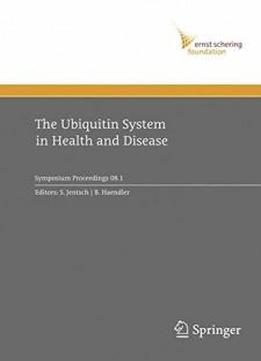
The Ubiquitin System In Health And Disease (ernst Schering Foundation Symposium Proceedings)
by Bernhard Haendler /
2008 / English / PDF
2.4 MB Download
The ubiquitin system has two major functions in eukaryotic cells:
it r- ulates protein degradation, which is essential for normal
cellular fu- tion and for the removal of potentially harmful,
damaged, or misfolded proteins, and it controls protein activity by
regulating protein–protein interactions and subcellullar
localization. The ubiquitin system is thus involved in processes as
diverse as cell cycle progression, signal tra- duction, gene
transcription, and DNA repair. Not surprisingly, defects in the
ubiquitin system have been linked with numerous diseases such as
cancer, in?ammation, central nervous system disorders, and
metabolic dysfunction. Ubiquitin is a highly conserved 76-amino
acid protein which is transferred to its target protein in an
ATP-dependent manner. This post-translational modi?cation takes
place in a hierarchical, three-step fashion involving an E1
ubiquitin-activating enzyme, an E2 ubiquit- conjugating enzyme, and
an E3 ubiquitin ligase. Substrate speci?city is predominantly
controlled by members of a large family of E3 - zymes, which form
complexes with the proteins that will be modi?ed. This ultimately
leads to the covalent attachment of the C-terminus of ubiquitin to
usually an?-amino group of a lysine residue in the targeted
protein. Additional ubiquitin transfer to lysine-48 of ubiquitin
itself will form a polyubiquitin chain, which usually targets the
conjugate for degradation by the proteasome. By contrast, mono- or
polyubiquityla- VI Preface tion involving lysine-63 is normally
involved in the control of protein activity. Ubiquitylation can be
reverted by deubiquitylating enzymes, of which approximately 95
exist in mammals.
The ubiquitin system has two major functions in eukaryotic cells:
it r- ulates protein degradation, which is essential for normal
cellular fu- tion and for the removal of potentially harmful,
damaged, or misfolded proteins, and it controls protein activity by
regulating protein–protein interactions and subcellullar
localization. The ubiquitin system is thus involved in processes as
diverse as cell cycle progression, signal tra- duction, gene
transcription, and DNA repair. Not surprisingly, defects in the
ubiquitin system have been linked with numerous diseases such as
cancer, in?ammation, central nervous system disorders, and
metabolic dysfunction. Ubiquitin is a highly conserved 76-amino
acid protein which is transferred to its target protein in an
ATP-dependent manner. This post-translational modi?cation takes
place in a hierarchical, three-step fashion involving an E1
ubiquitin-activating enzyme, an E2 ubiquit- conjugating enzyme, and
an E3 ubiquitin ligase. Substrate speci?city is predominantly
controlled by members of a large family of E3 - zymes, which form
complexes with the proteins that will be modi?ed. This ultimately
leads to the covalent attachment of the C-terminus of ubiquitin to
usually an?-amino group of a lysine residue in the targeted
protein. Additional ubiquitin transfer to lysine-48 of ubiquitin
itself will form a polyubiquitin chain, which usually targets the
conjugate for degradation by the proteasome. By contrast, mono- or
polyubiquityla- VI Preface tion involving lysine-63 is normally
involved in the control of protein activity. Ubiquitylation can be
reverted by deubiquitylating enzymes, of which approximately 95
exist in mammals.











